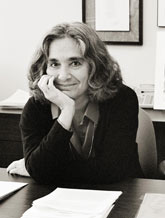
Handy Links
SLAC News Center
SLAC Today
- Subscribe
- Archives: Feb 2006-May 20, 2011
- Archives: May 23, 2011 and later
- Submit Feedback or Story Ideas
- About SLAC Today
SLAC News
Lab News
- Interactions
- Lightsources.org
- ILC NewsLine
- Int'l Science Grid This Week
- Fermilab Today
- Berkeley Lab News
- @brookhaven TODAY
- DOE Pulse
- CERN Courier
- DESY inForm
- US / LHC
SLAC Links
- Emergency
- Safety
- Policy Repository
- Site Entry Form

- Site Maps
- M & O Review
- Computing Status & Calendar
- SLAC Colloquium
- SLACspeak
- SLACspace
- SLAC Logo
- Café Menu
- Flea Market
- Web E-mail
- Marguerite Shuttle
- Discount Commuter Passes
-
Award Reporting Form
- SPIRES
- SciDoc
- Activity Groups
- Library
Stanford
Around the Bay
From the Director: Remarks on the Dedication of LCLS

On Friday, April 10, 2009 at 10 p.m. the phone rang. I was sound asleep (lab directors go to bed early on Friday night) and as I struggled to open my eyes, the voice on the other end said "We have a laser!" And with that, the LCLS era at SLAC had begun.
The seeds for that late-night, jubilant announcement had been planted many years earlier. It began with a very smart accelerator physicist, Claudio Pellegrini, with a very good idea and a vision. That vision, helped, fostered and developed by Herman Winick and accelerator physicists at SLAC and elsewhere, was to use the SLAC linac to make the world's first X-ray FEL. Claudio and Herman organized workshops. With the help of Max Cornacchia, working groups were formed and the first design report was written. SSRL directors Bienenstock and Hodgson along with lab directors Richter and Dorfan gave their support. Working with the Department of Energy and the X-ray community, the Linac Coherent Light Source project came into being.
But building an X-ray free-electron laser is another challenge altogether. John Galayda came to SLAC to build the LCLS, and with help from Mark Reichanadter, Paul Emma and the entire LCLS team, he did just that. And John, Mark and Paul needed help from the entire laboratory to make LCLS a success. Every one of you, in some way, contributed to this triumph for the laboratory.
But we at SLAC could not have delivered LCLS on our own. We needed the help of our friends. We needed incredible support from Hanley Lee and the DOE site office, who worked with us side by side, day by day. Stanford University was always there when we needed them. We appreciated the unwavering support of the program office, Pat Dehmer, Harriet Kung and Pedro Montano, who helped us maneuver through continuing resolutions that hit the project every year during its construction. We needed Dan Lehman, who helped the project stay on track with his "tough love" form of project oversight, for which we are deeply grateful. Our sister labs and universities—Argonne National Laboratory, Brookhaven National Laboratory, Lawrence Livermore National Laboratory and UC Los Angeles—were critical parts of the project. Lawrence Berkeley National Laboratory was a supportive partner all the way through. And Pacific Northwest National Laboratory provided critical leadership when we needed it.
And now, we have a facility that is annihilating expectations. The turn-on went better than we could have dreamed. The early experiments are swimming in data and are already exploring new frontiers. The science is starting to flow.
On Monday, August 16, we dedicated the facility and celebrated its early success. Ten years from now, when we are working on other projects or perhaps sitting comfortably in an armchair somewhere, we will look back on LCLS and perhaps it will look like any other project. But today, the efforts that have brought us to this point seem heroic to me.
To all of you who have contributed to the success of the project, congratulations. To all of you who came to help us celebrate; thank you for your help, support and dedication over the years. Some of you had faith in us when we didn't have faith in ourselves. We will always be grateful. LCLS has opened a new era of science for SLAC and for the nation. SLAC has reinvented itself once again and we are all excited about the future that will unfold.
